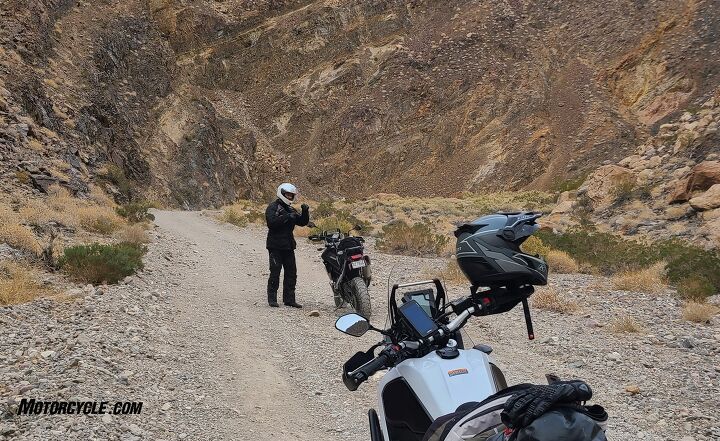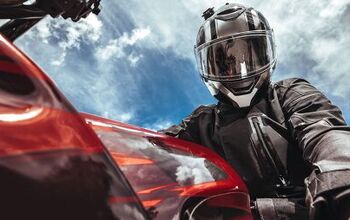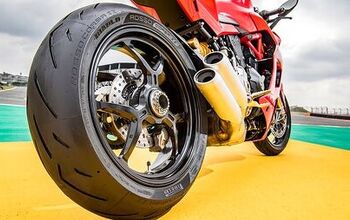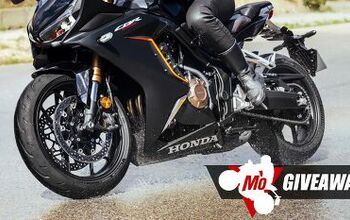Motorcycle GPS: Why your phone isn't good enough

Or is it?
Before we get too far into this, let’s face it, smartphones have come a long way and are capable of doing things most don’t understand and some can’t comprehend. Navigation, however, is one of the features people from all walks – and levels of technological literacy – use on a daily basis. A smartphone works quite well for nav among dozens of other things, occasionally at the same time. So are standalone GPS units even worth having around anymore? As phones continue to advance – as well as GPS units – the lines between the two continue to become more blurred. Let’s have a closer look at the pros and cons of both.
Smartphone VS GPS ULTIMATE DEATHMATCH!!!
Most smartphones have a lot to offer by way of modern conveniences. In fact, convenience is probably the biggest pro that smartphones have going for them. One device to rule them all. You can do so much with modern smartphones in addition to navigation. Having one device to carry around is the ultimate convenience.
On the flip side, I wouldn’t want to mount my smartphone – that I use and rely on for so many other things – on the handlebars of my dirtbike. I think I paid $120 for the first Garmin GPS that I used for navigating off-road. That is significantly less than the Samsung Galaxy S20+ that I keep safely stowed in my pack during rides. Most GPS units built for motorcycling or outdoor use are built to MIL-spec standards that include weatherproofness and impact resistance. Heck, when I was on vacation in Nevada, my GPS unit ended up separated from the motorcycle and down the trail from a hard, fast get-off. Afterward, it worked as though nothing had happened without a scratch on the thing.
At one time you might have been able to argue that the screens on cell phones were too small, but that’s no longer the case. The Garmin Montana 700i sitting on my desk has a five inch screen while the Samsung Galaxy’s next to it measures over 6.5 inches. And while the Montana 700i screen is pretty brilliant for a GPS, the Samsung’s is at a different level. That said, I don’t need all of those pixels while I’m on the motorcycle, and GPS units made specifically for riding put an emphasis on visibility in adverse or pleasant sunny conditions. Most can also be used with gloved hands.
Battery life is another point of consideration. For a phone, running GPS-based apps takes a lot of effort. A GPS is built to provide maximum performance for one thing, navigating. Both can be tailored to use less battery life by changing settings, but there’s a good chance the standalone GPS unit will outperform a phone. And, if you find yourself in trouble at the end of the day, it’s probably better to have a dead GPS and a fully charged phone than the other way around. That said, this point is moot if you have a wired power connection on your motorcycle for a phone or GPS.
Then there’s the point of actual GPS functionality. A phone’s GPS works best when it can connect to the internet, cellular service, and satellites because most smartphones use a form of GPS called A-GPS – A for “assisted”. This means the phone uses all three of the aforementioned data points to present the user with navigation, traffic info, etc. Unless you have downloaded maps in advance, your phone will need to continuously download map information about your trip along the way. With a standalone GPS, a much larger map is actually native on the device itself, not just a portion – to an extent anyway. Most GPS devices will include maps of the area where it was sold, North America, for example. Google, or whatever navigation app you use, may have some map data cached, but not nearly the amount a GPS unit has.
Speaking of Google, it’s public knowledge that Big G hoovers up as much data as it can from whatever Google product you might be using. For those who are concerned about privacy, using any smartphone-based app will likely be a deal-breaker. In the case of GPS, nothing is being transmitted out of the device (unless you tell it to do so with newer GPS features). The GPS satellite receiver gets its coordinates from satellites, where you are or are going, and displays it on the map.
Stand alone GPS units also work well for traveling, particularly for traveling internationally. Most of the time, for smartphone users, if you travel from, say, the US to Spain, your cell phone provider will ding you with an international usage fee if you plan to use your cell phone while you’re traveling. A GPS – as long as you have the region you’re traveling to downloaded – will work just as well as it did back home. In my experience, even when I have paid to use my smartphone internationally, it never works quite as well as it does back home.
If you’re still considering a motorcycle GPS at this point, I’ve included a few of the top units below.
Garmin Montana 700i
The Montana has been a favorite of off-road and adventure riders for many years. It has a large, well-lit, five-inch touch screen and enough memory to store tracks for a ride around the world. It also has the ability to store multiple map sets simultaneously, allowing you to switch from a hard-core topographic map set to a more road-friendly set, like City Navigator. Though the Montana is marketed toward hiking, there are plenty of riders we know who swear by them for use off-road.
The Montana 750i features an eight megapixel rear facing camera which automatically geotags pictures, helping you to better remember points of interest when looking back at your tracks. The 700 series also includes a built-in three-axis compass with barometric altimeter and the ability to share your files with other compatible Garmin units wirelessly.
The Montana 700 series gains extra functionality if you link it to your smartphone such as live weather updates. See, they can work in harmony. In addition to that functionality, with the 700i and 750i, you can purchase a separate satellite subscription which will then allow you to use Garmin’s inReach SOS technology should you find yourself in trouble. This also allows messages to be sent via satellite which can come in handy if you’re waayyy out of cell service.
A great unit for those focused on off-road riding while still being able to navigate the odd stretch (or more) of pavement.
Garmin Zumo 396 LMT-S
Garmin’s Zumo 396 LMT-S is the slightly smaller brother to the 595LM. The Zumo line was the first truly motorcycle-specific GPS offered on the market. Since its inception, it’s been refined with thousands (if not millions) of user-tested miles on motorcycles. Though intended primarily for use on streetbikes, it can also be used for mild adventure riding, too. Like all Garmin products, it uses Garmin’s collection of proprietary mapping products with domestic and international coverage.
The Zumo 396 LMT-S packs a GPS-load of features for its price point. The unit features a 4.3-inch glove-friendly, sunlight-readable display which is resistant to harsh fuel vapors as well as UV rays it will likely find itself in the majority of the time. As far as software goes, users will have the ability to connect their smartphones via the Smartphone Link app which allows for hands-free calling, smart notifications, and control of music playlists. Live weather and traffic information can also be viewed when the Zumo 396 LMT-S is connected to your smartphone.
Garmin Adventurous Routing helps riders find the best roads for motorcyclists with adjustable parameters such as hills, curves, and the option to avoid major highways. Automatic incident reporting and rider alerts are also helpful to give a heads-up for upcoming curves, animal crossings, and real-time traffic incidents. Wi-fi is also available for easily keeping your maps up to date. To round out the laundry list of features, the 396 LMT-S has a built-inservice log in which you can set notifications for service items such as brake pads, air filters, etc. to be checked.
TomTom Rider 550
TomTom has been designing and manufacturing GPS units with a solid motorcycle pedigree for a long time. Several OEMs have partnered with TomTom for original equipment installations on premium streetbike models. Though TomTom seems to have lost the battle with Garmin for popularity, they still produce a quality product, which is seen in the Rider 550.
TomTom’s maps, traffic, and safety camera alerts are all available to Rider 550 users for the useful lifetime of their GPS. Bluetooth smartphone connectivity is available for calling and messaging as is the ability to use Google Now and Siri voice controls with your connected helmet. Like Garmin’s adventure routing, TomTom too allows for elevation and curve level setting when constructing routes to deliver motorcyclists the desired thrill they are looking for. If you’ve got any friends, you can share your route through social media, email, or by GPX file with other compatible GPS units. Wi-fi updates are available to update maps wirelessly making staying current a cinch. Touchscreen sensitivity is also adjustable for thick or thin gloves to give users the most optimal touchscreen experience. The TomTom Rider 550 is a feature-rich GPS unit that punches above its price point.
What do I use?
Day-to-day, I use my smartphone for navigation if I’m staying on pavement. I have a few different mounts, like the Rokform system that I reviewed the other day, that are easy enough to swap between motorcycles. Like I said before, the convenience of one device cannot be understated. For me though, it all changes when I’m heading off-road.
For one, I don’t want to risk damaging my phone in the instance of a tip over in the dirt. The Garmin Montana 700i that I’m using now retails for $700. So, I don’t want to break that either, but as mentioned above, if one were to get broken, I’d rather it be the GPS. The Montana series is also one of the more expensive, feature-rich units on the market. In the case of the Garmin Zumo and TomTom Rider, they’re a few hundred dollars less. And then, of course, there’s also the used market. Many Garmin devices come with lifetime map updates.
I like to use my GPS for exploring. I’ll make a route to follow, but I may want to deviate from it to see where the odd trail goes. Maybe it will be a more interesting, fun, or scenic route to where I was headed anyway – or maybe it will dead end. Either way, using the GPS to not only show me my route, but to also track where I’ve been (making notes along the way like “dead end”), is a feature I don’t think many motorcyclists think about when considering whether they want to buy a GPS unit. I know folks who’ve done this since GPS units became popular who now have massive archives of routes that they’ve explored, come home from, cleaned up, and saved for future use. It’s my favorite way to use the GPS, and the reason I opted for the Montana versus the Zumo.
So which one is better?
This probably won’t come as a surprise by this point, but it depends. What do you want out of your navigation device? Do you want it to navigate around major cities or well burned in routes, then a phone is probably fine. Or do you plan to get lost just for the challenge of finding your way back? Then a GPS unit and its satellite-based functionality will probably better suit your needs.
Whatever you decide is best for you, I hope this article helped to highlight the pros and cons of each option. Let us know in the comments which you prefer and how you use it.
We are committed to finding, researching, and recommending the best products. We earn commissions from purchases you make using the retail links in our product reviews. Learn more about how this works.
Become a Motorcycle.com insider. Get the latest motorcycle news first by subscribing to our newsletter here.

Ryan’s time in the motorcycle industry has revolved around sales and marketing prior to landing a gig at Motorcycle.com. An avid motorcyclist, interested in all shapes, sizes, and colors of motorized two-wheeled vehicles, Ryan brings a young, passionate enthusiasm to the digital pages of MO.
More by Ryan Adams





































Comments
Join the conversation
I didn't see a mention of a cel phone shutting down because of heat. And not that hot, either. Need to take it off the bike when the bike is sitting in the hot sun.
I've been looking at (Chinese) "rugged" smartphones in the $300-400 range. Specifically the Doogee V20 which is built to military spec and is IP68, IP69K and STD-810G rated plus lots of other nice features/specs including a big 6.4" AMOLED screen. Pretty much checks all the boxes and costs less than all the dedicated GPS units mentioned. Just something else to consider.